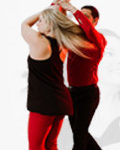West coast swing pulses on the upbeats, so our normal triple step is designed to give a full beat of music to the upbeat; the & of the triple comes between the downbeat and the upbeat.

The syncopated triple rhythm flips this pulse: the & count occurs before the downbeat in order to make the downbeat feel accented.

The Drill: Without a partner, put on a song and practice doing triple steps with the basic rhythm. Then, switch to syncopated triples. Since the & now comes before the downbeat, you need to start the & count as soon as you finish the previous upbeat. There’s no time for a coffee break.
Once you can fluidly do the syncopated triples, try dancing basic rhythms and alternating between syncopated triples and standard triples.
A word of caution: It is very easy for syncopated triples to become your basic rhythm because so much contemporary WCS music has frequent accents on the downbeats. Push break and tuck-based moves are particularly vulnerable, since it is extraordinarily easy to use the &3 to hit an accent and then dance out on the 4, rather than letting the compression build through 3&. When you are practicing syncopated triples, be sure that you are doing them deliberately and that your basic still remains the standard triple rhythm. For the tempting moves like push breaks and tucks, I would strongly recommend that you finish a session by practicing those moves a couple of times with normal triples to make sure that you reinforce the standard rhythm.
Bonus Variations: Just like you can stylize your normal triples with different foot positions, you can also change up the foot placement for syncopated triples. Experiment to find out what positions work for your body and practice putting those movements into specific patterns or anchors.




 Brian & Megan
Brian & Megan